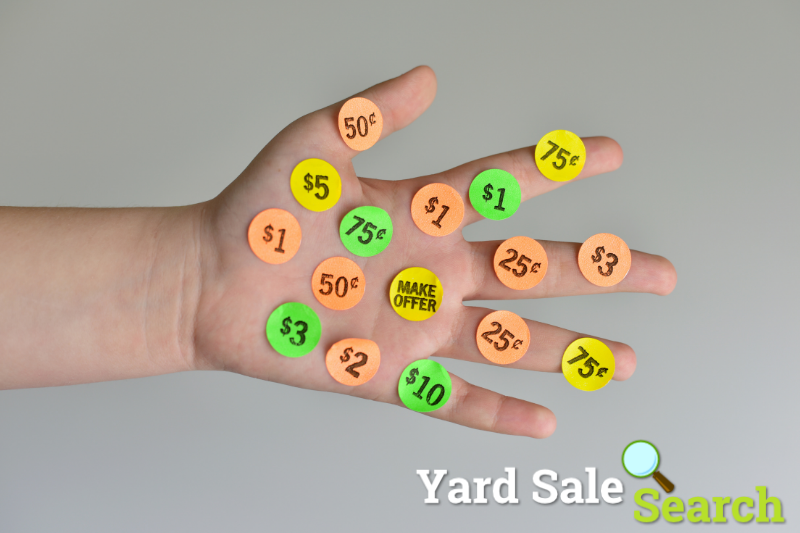A bit of extra cash and a decluttered living space—is a yard sale the best thing that can happen to you? Maybe not, but for the purposes of this blog post, let’s just say it is. A yard sale isn’t the most difficult thing in the world to pull off, but just how much money you make and how much stress you avoid throughout the event can depend mostly on a few key organizational skills.
There are plenty of important steps to take and nuances to learn before setting up your yard sale, like learning what not to sell at a garage sale or knowing how to get a yard sale permit if necessary. However, perhaps the most important and difficult of these skills is working out pricing for each of your items. Don’t stress about it, though, we’ve got you covered!
Deciding Prices
Look down, are you wearing shoes? How much would you sell them for? If you said retail price, please keep reading. If you said anything else, please keep reading. If you aren’t wearing shoes, please keep reading!
Truthfully, picking a price isn’t the easiest thing to do. It can be easy to want to ask for what you paid, but unless the item is fresh out of the store, it probably won’t be worth that. On the other hand, if the item is some sort of collectible that can be worth more than what you paid, a yard sale is not where you want to be letting go of it.
Maybe you spent hundreds of dollars on your Gucci slippers, but for all your potential customer knows, you might as well have used those slippers in public showers for the last few years (and maybe you did)! Besides, you’re getting rid of stuff that you don’t use or need, not selling a product you put hours of effort into. So how do you pick a price? One common, simple, and effective method is to scope out the region. Especially if it’s Yard Sale Season where you are, pop into a few and see what similar items are going for. If books are being sold for $1 apiece, pricing yours higher might mean you’re left with unsold items at the end of the day, and pricing lower can mean missing out on some profit. If there aren’t yard sales going on at the same time, or they aren’t selling similar items, you can always check eBay, (used) Amazon listings, or even our quick pricing guide to get an idea.
One more tip here: don’t complicate things for yourself. Quick! What’s 3.39 + 7.98?! If the concept of adding awkward decimals stresses you out even a little bit, try setting your prices in 10 or 50 cent increments. Especially if your sale gets busy, you don’t want to slow down or get prices wrong by having to do some arithmetic on the fly.
Displaying Prices
You should have your prices figured out before you open up shop. Sure, you’re practically giving some of these things away, so a significant profit might be less of a priority than decluttering and socializing with your neighbors. Unless you want everyone to name their own price and go, having people coming up to you constantly just to clarify prices or to haggle can quickly get out of hand and stressful.
Once you have prices, though, be conscious about how you display them! You can mark items individually and clearly with stickers and a pen or a sharpie, or even color-code prices. If you have a bunch of similar items that will have the same price (like books or CDs), group them together and put up a sign. What you should try avoiding, however, is putting stickers on things that might get damaged, like books and vinyl covers. Your favorite old album on vinyl? Cool! A partially removed $5 sticker in the corner? Not so cool.
And of course, remember, used items are used! If the point of your yard sale is to get rid of items you no longer want or need, don’t stress too much about getting every price perfect. You can actually use this to your advantage, in fact. For example, if a customer tries to haggle for a price you aren’t ready to accept, try throwing in a free item instead! You might get rid of the lamp you don’t want anyway, and the customer walks away with a better deal.
Another advantage of having those items that you just want to get rid of is using them to add some more allure to your yard sale. When thinking about how to organize a yard sale, a free or very low price section can be a great way of bundling together items you just need taken out of your hands quick, and it’s a great way of getting customers talking about the great finds they found in your yard or garage. This free publicity takes some mystery out of how to promote a yard sale, and it might also convince some guests that spending a little more on some other items is more feasible. After grabbing some shirts off of the free rack, $20 on a nice pair of jeans in great shape suddenly doesn’t feel so bad!
Whether your focus is on getting rid of some junk or getting a hold of some cash, appropriate pricing is going to be one of the most important ingredients. That being said, perfect pricing isn’t the end all be all of a great yard sale either, so don’t let it stress you out too much. If your focus is on maximizing your revenue over the weekend, or whenever you’re holding your sale, paying close attention to these pricing tips, as well as being careful about what sells at yard sales and how to prepare for a yard sale will be important. Many people set up yard sales to declutter their homes, with the extra cash being less critical. If this sounds like you, then pricing your items a little low might even be a better way of making sure you sell out!
Whatever your specific yard sale goals may be, this is far from an ultimate guide, but hopefully, these tips will help your old stuff find new owners. Long live the yard sale!
Yard Sale Search is the most popular platform to post your yard sales and garage sales online. If you want to get maximum visibility on the web, then you need to post your yard sale with us.





